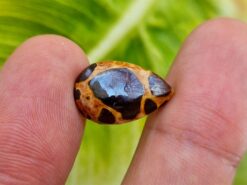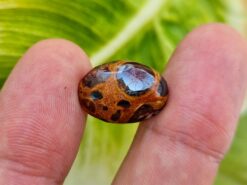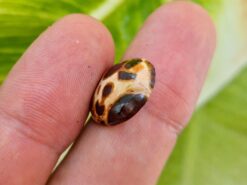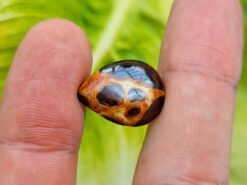Bauxite

Bauxite mineral meaning and uses, an ore of aluminum.
Buy natural bauxite in our shop
Bauxite is a sedimentary mineral with a relatively high aluminium content. It is the world’s main source of aluminium and gallium. The stone consists mostly of the aluminium minerals gibbsite , boehmite and diaspore , mixed with the two iron oxides goethite and hematite , the aluminium clay mineral kaolinite and small amounts of anatase and ilmenite .
Formation
Numerous classification schemes have been proposed for bauxite.
Vadász (1951) distinguished lateritic (silicate) from karst bauxite ores (carbonate):
- The carbonate bauxites occur predominantly in Europe, Guyana, and Jamaica above carbonate rocks (limestone and dolomite), where they were formed by lateritic weathering and residual accumulation of intercalated clay layers – dispersed clays which were concentrated as the enclosing limestones gradually dissolved during chemical weathering.
- The lateritic stones are found mostly in the countries of the tropics. They were formed by lateritization of various silicate rocks such as granite, gneiss, basalt, syenite, and shale. In comparison with the iron-rich laterites, the formation of this stones depends even more on intense weathering conditions in a location with very good drainage. This enables the dissolution of the kaolinite and the precipitation of the gibbsite. Zones with highest aluminium content are frequently located below a ferruginous surface layer. The aluminium hydroxide in the lateritic deposits is almost exclusively gibbsite.
In the case of Jamaica, recent analysis of the soils showed elevated levels of cadmium, suggesting that the stones originates from recent Miocene ash deposits from episodes of significant volcanism in Central America.
Bauxite, from Australia
Production
Australia is the largest producer , followed by China. In 2017, China was the top producer of aluminum with almost half of the world’s production, followed by Russia, Canada, and India.
Although aluminum demand is rapidly increasing, known reserves of its stones ore are sufficient to meet the worldwide demands for aluminum for many centuries. Increased aluminum recycling, which has the advantage of lowering the cost in electric power in producing aluminum, will considerably extend the world’s reserves.
Bauxite uses and meaning and healing properties benefits
The following section is pseudo scientific and based on cultural beliefs.
Bauxite uses and meaning
The stone can be used in meditation, and this may be helpful to help you to obtain answers to situations that may be concerning you
It may also allow you to be aware of the intentions of others. It is known to help to create an increase of feelings of happiness and heightened well being.
It does not work immediately but if it is kept in your vicinity, its energy works to stimulate you over time.
By assisting you to release emotional issues that are stopping you from achieving what you desire, it may help you to release feelings that are causing you to feel angry or resentful about the circumstances of your life.
Bauxite under microscope
FAQ
What is bauxite used for?
The stone is used to produce alumina, which is then used to produce aluminum. Wastes can be generated at several points in the production process, including during the mining of the ore, and during the refinery production process.
How bauxite is formed?
The gemstone is formed by the thorough weathering of many different rocks. Clay minerals commonly represent intermediate stages, but some stones appear to be reworked chemical precipitates rather than simple alteration products. It may grade into laterite or clay, laterally or vertically.
What bauxite looks like?
It is typically a soft material with a hardness of only 1 to 3 on the Mohs scale. It is white to gray to reddish brown with a pisolitic structure, earthy luster and a low specific gravity of between 2.0 and 2.5.
What color is bauxite?
The stone is reddish-brown, white, tan, and tan-yellow. It is dull to earthy in luster and can look like clay or soil.
Which country has the most bauxite?
In 2020, Australia produced the largest amount worldwide. In that year, the country produced 110 million metric tons. Following Australia was Guinea, which produced 82 million metric tons of the rock.
Natural bauxite for sale in our shop
We make custom made bauxite as engagement rings, necklaces, stud earrings, bracelets, pendants… Please contact us for a quote.
















